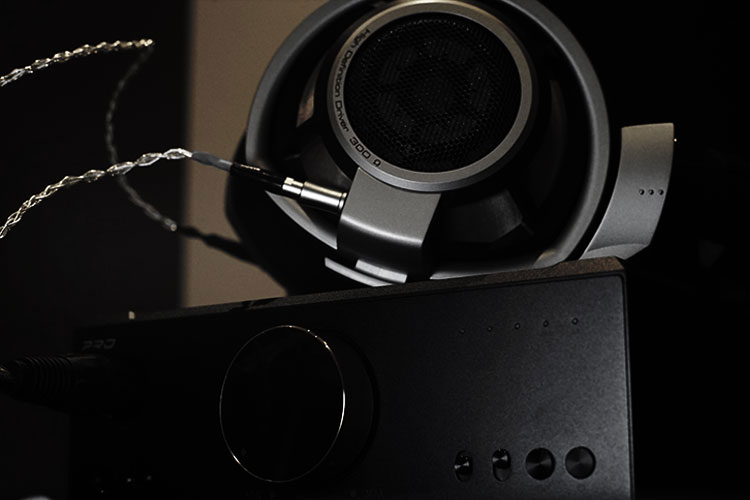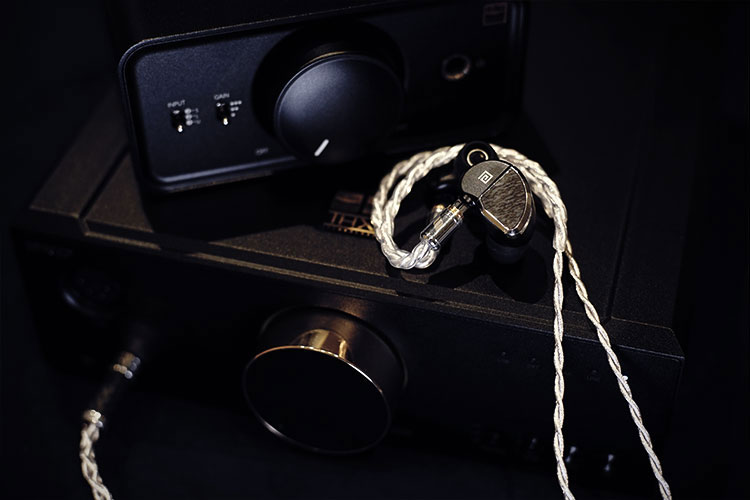Synergy
Efficiency
Both the K5 Pro ESS and K9 Pro ESS are very quiet on low gain and when switching to the higher gain you may hear some faint hiss that is negligible when the music is on. It is more audible on the K5 Pro ESS when testing with IEMs but with background seems blacker with the K9 Pro ESS even though it has the higher output rating.
With <1.2Ω output impedance even very sensitive IEMs like the SE846 sound dynamic on it and there is enough power to handle cans like HD600 without sounding loosened up. On K9 Pro ESS that has <1Ω impedance, it displays a stronger sense of control and more openness in the upper register.
Both DAC & amps are able to drive headphones loud and you could easily feel the K9 Pro ESS being more powerful with a stronger staging performance. In short, both are flexible with different earphones and headphones with great noise control performance to offer even at higher gain levels.
Power
The K5 Pro ESS is considered quite powerful for its price with 1.5W in the output. Therefore it can handle various headphones and high impedance IEMs with no sign of muddiness or lack of dynamics. It can handle 300Ω earbuds and power high impedance studio cans fairly well.
For me, the K9 Pro ESS is quite a bit more powerful and packed with a linear transformer inside with stronger dynamics and responsiveness that can handle strong bass attacks with ease.
At higher gain it could power demanding headphones like the HD800, outputting strong transients and a solid bass punch that favors percussion and synthesized instruments.
Pairings
I am having a lot of fun putting different gears on the K5 Pro ESS and K9 Pro ESS, as it is not necessarily the more expensive, or technically the strongest gear paired together that will yield the best result.
Below I have chosen 3 headphones and 3 earphones that are extensively used to test different products and could help explain what the two DAC & amps best pair with and what don’t.
Sennheiser HD600
With strong output power and a rather V-shaped tuning, I was expecting good synergy with the warm-sounding HD600 that requires some good power to drive. In practice, the K5 Pro ESS met that expectation offering a great synergy with the HD600. It sounded clean, punchy, and very smooth in the midrange frequencies.
Headphones that are colored or thickened in the vocal range will be balanced out to sound swifter and smoother, taking away the thickness yet the vocal is still being well separated with the small bump in the upper mids. The smooth, non-fatiguing sound with good air is perfect for casual listening on YouTube, playing some lo-fi house music, and clean jazz.
The K9 Pro ESS, on the other hand, is stronger in technicalities and presents the microdetails and transients much clearer, also feeling a lot more expanded in all directions. It may feel clinical or recessed in the mids when pairing with some fast, clean-toned headphones but with the HD600 that has good punch in the mid-lows, it is a fine match.
Do not expect intense, up-front vocal, but tranquility and control that has decent texture and airiness. Acoustic instruments sound live-like, responsive, and not lacking in body, and the pairing favors as well woodwinds, flutes, and lighter voices.
If you have bassy, mid-lows intensive cans that you want to improve the extension and detail retrieval then the K5 Pro ESS offers excellent value and a level of neutrality that might even be used for monitoring purposes. While the K9 Pro ESS value for retro cans pairing and for those who do not need the filtering options nor Bluetooth connectivity.
Fostex TH900
Under the beautifully lacquered wood cups, the neutrally tuned TH900 has 1.5 Tesla drivers that can sound highly dynamic when sufficiently powered.
When linked up to the K5 Pro ESS, the output is very fast, and dynamic, emphasizing the lows and upper mids, which works great with instrumentals. The vocals sound slightly thin with their edges in the upper mids emphasized. When it comes to thicker voices the body may be lacking yet it is sounding swifter with music genres that have a cleaner timbre.
The K9 Pro ESS offers a higher degree of control when paired with TH900. While maintaining little coloration, there is a better extension, definition to the midrange, stronger transients, and layering in the bass.
This pattern to the performance defines the whole output spectrum as clearer and more layered sounding. The smooth and airy treble is attention-stealing, when focusing on the mid-lows there is decent punching power and density.
Sennheiser HD800
The HD800 is one of the more demanding headphones and in the balanced configuration, it utilizes the K9 Pro ESS’s multiple stage amplification to sound defined, airy and responsive in the lows.
There is sufficient swing and current to give the bass body and texture, such that it doesn’t bleed over the midrange frequencies. The articulation is very smooth transitioning to the higher register and to me it renders the right mood and pace playing club mixes and city pops from the 80s.
Listening carefully to the K5 Pro ESS with the 6.3mm cable, you can feel the level of details is not as strong as on the K9 Pro ESS yet there are satisfactory dynamics and clarity. It would have cost a lot more to get similar performance on amplifiers when HD800 first came out to achieve such qualities here, especially when considering its size.
The HD800 serves as a good testing control. While the technical performance is decent, warmer sources are still preferable with it but I would expect the HD 8XX or HD800s to have greater synergy on both units.
Final A8000
While sensitive IEMs may be overly driven, A8000 has the ability to gulp up more power. On K5 Pro ESS, the A8000 punches strong in the bass and you could easily feel the raw power the amplifier can offer.
Playing drum solos, the bass kicks are solid and firm, but the energy in the bass is a bit overwhelming so bass guitars and drums get more focus than the vocalist. Lighter or higher pitch voices get better separation with instruments in this case and the strong power is compromising the responsiveness.
On K9 Pro ESS you can hear the bass punching much deeper and more texture is brought to the audience. The level of control in the bass is enhanced so there is more openness for the mid-range instruments and vocals.
At the same time, the transient response in the higher register is stronger. Playing the Transformers 4 soundtrack the SFX sounds a lot more realistic, and the mechanical hum and vibrations are very dynamic.
Shure SE846
Testing with the sensitive SE846 on the K5 Pro ESS its low 9Ω impedance rating produced sharp and clear performance. The background is satisfactorily clean, however, even at a low gain, it is slightly over-powering so the SE846 sounds compressed in the mids, though the bass punch is quite strong. Amping the SE846 also enhances the intensity of the upper mids.
The SE846 and other lower impedance IEMs for example the Andromeda 2020, are more controlled on the K9 Pro ESS. There is more openness in the upper register, and the output is more 3D and defined.
Effect Audio Axiom
I’m picking the Axiom to be paired as it requires a lot of power as well as a good level of control to drive it to the full extent. The K5 Pro ESS feeds the Axiom with plenty of raw power and achieves good balance together.
The bass sounds full offering a satisfactory depth that works well with pops and rocks. The power is better than on many mid-tier DAPs and could rival some higher-end DAPs though some details in the mid-range frequencies are smoothened out.
Using a balanced connection, the K9 Pro ESS sounds much more open with stronger dynamics. The separation, as well as the staging performance, is clearly improved and the treble is much more refined, with far less obvious roll-off.
Using Guns & Roses’ Welcome to the Jungle to test, the bass guitar sounds meatier and more textured than on the K5 Pro ESS. The vocal line also has more power to cut through the mix.
Our Verdict
Both of these desktop units on the test bench sound refreshing and with the right pairing, they can sound very engaging. Therefore deciding between the two will come down to a few specific factors.
If you use only 6.35mm terminated cans, especially retro ones that are more colored with thicker mids, the very neutral K5 Pro ESS is a well-built and affordable option offering decent output power.
For anyone who needs more advanced features and with a deeper pocket, I would definitely recommend getting the K9 Pro ESS. It provides more finesse over its powerful balanced connection, and wireless connectivity to produce a much more comprehensive product experience, let alone higher fidelity.
FiiO K9 Pro ESS Specifications
- Power supply: AC+Built-in linear power supply
- Digital inputs: USB/Coaxial/Optical/Bluetooth
- Analog Input: RCA/4.4mm Balanced
- USB B and USB C connectors
- Headphone outputs: 4-pin XLR/4.4mm Balances, 6.35mm single-ended
- Line-out: RCA/XLR
- Seven Digital Filters
- PCM Decoding: Up to 32-Bit/384kHz
- DSD256 native decoding
- Audio clock: High-precision PLL+Dual crystal oscillators
- Output power(SE): 2.1W(16Ω), 281mW(300Ω)
- Output power(Bal): 2.1W(32Ω), 1.1W(300Ω)
- THD+N: ≤0.00025%
- SNR: ≥129dB
- Line level: Up to 5.8Vrms.
FiiO K5 Pro ESS Specifications
- DAC chip ES9038Q2M
- Decoding chip XMOS XUF208
- Output power >1.5W 32Ohms
- Output impedance 1.2Ohms (PO)
- THD+N <0.0009% (UAC IN/SPDIF)
- Noise floor <8uV (A Weighted)
- SNR >118dB
- Channel Separation >80dB (USB DAC/OPT/COX)
- Outputs RCA/6.35mm
- Inputs USB-B/OPT/COAX/RCA
- DSD 64/128/256/512 decoding
- Weight about 480g
- Dimensions 120 x 146.5 x 55mm






